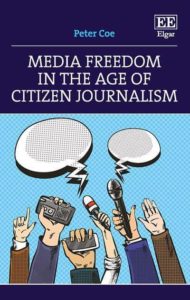 The ILPC Book Launch Event – Media Freedom in the Age of Citizen Journalism (Elgar Law 2021) took place on 11th May. The ILPC was delighted to host this online event and congratulates former ILPC Research Associate Dr Peter Coe (University of Reading) on its publication.
The ILPC Book Launch Event – Media Freedom in the Age of Citizen Journalism (Elgar Law 2021) took place on 11th May. The ILPC was delighted to host this online event and congratulates former ILPC Research Associate Dr Peter Coe (University of Reading) on its publication.
This timely and highly topical event was organised as a panel discussion with an impressive and international panel of speakers from academia, regulation, and legal practice – Professor David Rolph (University of Sydney), Professor Paul Wragg (University of Leeds), Rebecca Moosavian (University of Leeds), Lexie Kirkconnell-Kawana (Head of Regulation at IMPRESS), and Professor András Koltay (President, Hungarian Communication and Media Authority).
The event kicked off with a brief introduction by the author. Speaking about his motivations for writing the book, Dr Peter Coe highlighted how internet and social media have permanently altered the media ecology and have shifted the media paradigm beyond recognition by enabling new actors to enter the media marketplace. It is this change in the media ecosystem, the shift that it has caused, and what it means for free speech, for laws relating to defamation, privacy, contempt of court and how we manage online anonymity and pseudonymity that fascinates him and provided him the motivation for writing the book.
He then gave an overview of some of the key claims made in the monograph.
A key idea explored in the book is why citizen journalism is gaining prominence. In highlighting the contributions that citizen journalism makes to the public sphere, he talked about how citizen journalists are no longer an outlier of free speech, rather they are central to how we communicate and receive information and ideas. Citizen journalists, he argues, provide real-time coverage of events as they unfold, from areas that are often inaccessible to professional reporters. They not only provide alternative content to what the mainstream media publishes or broadcasts, but they cover events that would have been missed entirely by institutional media. While explaining about the two categories of free speech (the personal right to freedom of expression and media freedom), he contended that in the current categorization of who belongs to which group, there’s a gap regarding a definable category of actors who are as citizen journalists effectively media, but are not always recognized as being media.
Lastly, he briefly discussed the book’s main contention, that media freedom as a normative concept needs to be modernized. Offered is an alternative normative framework that understands media freedom within the context of 21st century communication and the legal challenges it brings. He explained what the new functional concept – ‘media as a constitutional component concept’(MACC model), advanced in his book means, and highlighted how this conceptual framework would help with a number of legal challenges. These include: improving the credibility of anonymous and pseudonymous speech; helping to maintain fair trials whilst allowing citizen journalists to access court documents and legal proceedings; and promoting and protecting media freedom in the context of the law of defamation.
The panellists then provided their feedback on the book, and how they believe it contributes to the debates surrounding how we define journalists and regulate them in the current media environment.
All panellists noted the timeliness and importance of the work and research presented in the book, and commented on the rich range of issues it covers such as such as ‘fake news’, the shift from old media to new media, and regulating powerful modern platforms. They agreed that the ideas endorsed in the book are incredibly important and that the book has the capacity to have a positive, practical, and real-world impact. Importantly, the panel spoke about the general lack of public, academic, and even political understanding of how and why media freedom exists, how it operates and is regulated particularly online, and the concomitant responsibilities that accord to press freedom. They believe that the book clearly helps to foster this understanding and explains how rights cannot exist without certain responsibilities. In terms of areas for development in future legal research on this topic, the panel suggested further exploration of how social media platforms that are increasingly becoming sources of news, fit within the MACC model and how the regulatory framework proposed in the book could become a new foundation for press regulation, as such an approach is not common in Europe. Lastly, the panel also raised the issue of difficulty in classifying what constitutes Public Interest Speech – while the book puts forward a thoughtful approach to determining Public Interest speech, difficulty of categorising speech remains, as ultimately Public Interest and Non-Public Interest speech lie at each end of the spectrum.
The event concluded with a short Q&A session.
In sum, the event provided leading expertise and insights into a timely and crucial area of law and policy, particularly how social media and the Internet have affected the viability of the traditional institutional press and how the pressures generated by social media have encouraged journalists to publish content that appeals to the public, rather than high-quality content. The rich discussion also highlighted how crucial the Internet and social media have been in removing technological and financial barriers to producing and distributing content by allowing anyone with internet access to communicate instantaneously with mass audiences and making it possible for more voices to heard. In conclusion, the book is a must-read for those interested in journalism, media studies, human rights law, and communication studies. It lays the foundation for further research and makes a vital contribution to existing literature on media freedom and regulation.
